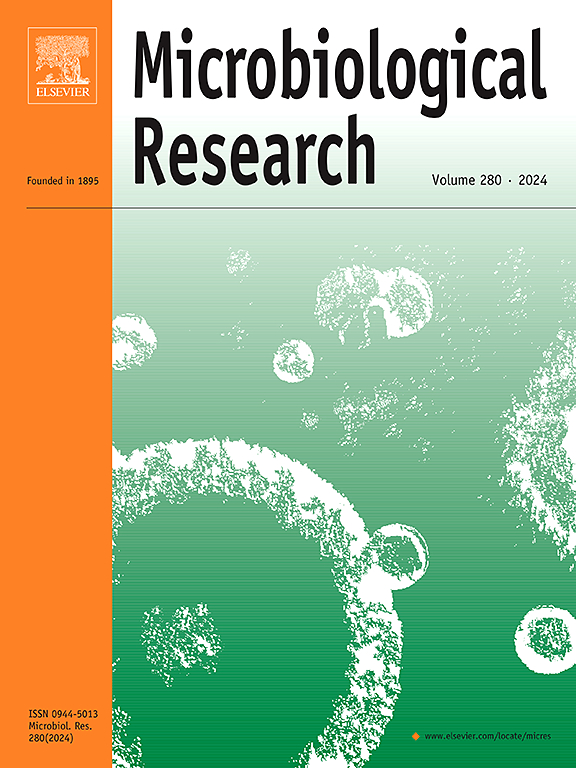丛枝菌根真菌和外源 Ca2+ 的应用通过不同的适应策略协同增强多年生黑麦草的抗盐抗碱能力
IF 6.1
1区 生物学
Q1 MICROBIOLOGY
引用次数: 0
摘要
随着全球人口增长和环境恶化加剧,土壤盐碱化的挑战及其对作物生产力的重大影响日益引起人们的关注。众所周知,丛枝菌根真菌(AMF)和钙离子(Ca2+)能增强植物的抗逆性,但它们对多年生黑麦草耐盐碱胁迫的综合影响及其内在机制仍鲜为人知。本研究旨在阐明丛枝菌根(AM)真菌根瘤菌(Rhizophagus irregularis)和外源 Ca2+ 在盐碱胁迫分子和生理反应中的作用。AM共生和外源Ca2+的应用增强了抗氧化酶活性和非酶成分,促进了活性氧(ROS)清除,降低了脂质过氧化,同时减轻了盐碱胁迫引起的氧化损伤。此外,在盐胁迫下,它们通过增加可溶性糖含量(对渗透调节的贡献比例在芽中为 34∼38%,在根中为 30∼37%)和有机酸含量(对渗透调节的贡献比例在芽中为 32∼36%,在根中为 37∼42%)来提高渗透平衡。有机溶质和无机阳离子-阴离子含量的变化有助于离子平衡,而激素调节在这些保护机制中也发挥了作用。此外,保护机制还包括激活 Ca2+ 介导的信号通路、调节盐碱胁迫相关基因(包括 LpNHX1 和 LpSOS1)、增加 ATP 酶活性、提高 ATP 水平、增强 Na+ 挤压、提高 K+ 吸收能力以及降低 Na+/K+ 比率,所有这些都有助于保护光合色素和提高光合效率。最终,外源 Ca2+ 和 AMF 的联合应用协同缓解了盐碱胁迫对多年生黑麦草生长的抑制作用。这一发现表明,外源 Ca2+ 可能参与了 R. irregularis 对多年生黑麦草植株的定殖,而 AM 共生可能激活 Ca2+ 途径。因此,在盐碱胁迫下,AM 和 Ca2+ 的联合处理有利于增强植物调节机制,提高作物产量。本文章由计算机程序翻译,如有差异,请以英文原文为准。
Arbuscular mycorrhizal fungi and exogenous Ca2+ application synergistically enhance salt and alkali resistance in perennial ryegrass through diverse adaptive strategies
The challenge of soil salinization and alkalization, with its significant impact on crop productivity, has raised growing concerns with global population growth and enhanced environmental degradation. Although arbuscular mycorrhizal fungi (AMF) and calcium ions (Ca2+) are known to enhance plant resistance to stress, their combined effects on perennial ryegrass’ tolerance to salt and alkali stress and the underlying mechanisms remain poorly understood. This study aimed to elucidate the roles of Arbuscular mycorrhizal (AM) fungus Rhizophagus irregularis and exogenous Ca2+ application in molecular and physiological responses to salt-alkali stress. AM symbiosis and exogenous Ca2+ application enhanced antioxidant enzyme activity and non-enzymatic components, promoting reactive oxygen species (ROS) scavenging and reducing lipid peroxidation while alleviating oxidative damage induced by salt-alkali stress. Furthermore, they enhanced osmotic balance by increasing soluble sugar content (Proportion of contribution of the osmotic adjustment were 34∼38 % in shoots and 30∼37 % in roots) under salt stress and organic acid content (Proportion of contribution of the osmotic adjustment were 32∼36 % in shoots and 37∼42 % in roots) under alkali stress. Changes in organic solute and inorganic cation-anion contents contributed to ion balance, while hormonal regulation played a role in these protective mechanisms. Moreover, the protective mechanisms involved activation of Ca2+-mediated signaling pathways, regulation of salt-alkali stress-related genes (including LpNHX1 and LpSOS1), increased ATPase activity, elevated ATP levels, enhanced Na+ extrusion, improved K+ absorption capacity, and a reduced Na+/K+ ratio, all contributing to the protection of photosynthetic pigments and the enhancement of photosynthetic efficiency. Ultimately, the combined application of exogenous Ca2+ and AMF synergistically alleviated the inhibitory effects of salt-alkali stress on perennial ryegrass growth. This finding suggested that exogenous Ca2+ may participate in the colonization of perennial ryegrass plants by R. irregularis, while AM symbiosis may activate Ca2+ pathways. Consequently, the combined treatment of AM and Ca2+ is beneficial for enhancing plant regulatory mechanisms and increasing crop yield under salt-alkali stress.
求助全文
通过发布文献求助,成功后即可免费获取论文全文。
去求助
来源期刊

Microbiological research
生物-微生物学
CiteScore
10.90
自引率
6.00%
发文量
249
审稿时长
29 days
期刊介绍:
Microbiological Research is devoted to publishing reports on prokaryotic and eukaryotic microorganisms such as yeasts, fungi, bacteria, archaea, and protozoa. Research on interactions between pathogenic microorganisms and their environment or hosts are also covered.
 求助内容:
求助内容: 应助结果提醒方式:
应助结果提醒方式:


